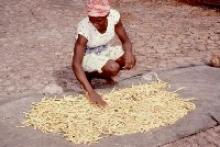Labour-saving technologies and practices: solar drying equipment
The following describes the preservation by solar drying of perishable fruits and vegetables. It highlights the features of solar drying as well as its advantages and disadvantages. These include labour saving, livelihood resilience strengthening, equipment, cost, skills, risk and infrastructure.
Description
Many perishable fruits and vegetables, such as raisins, prunes, and yams are preserved by solar drying. Speciality foods such as sun-dried tomatoes are also preserved this way. The crop is laid out in the sun at the start of the dry period on the ground. Sheets of material or simple racks are raised off the ground. When the crop is laid on bare ground, it can be damaged by pests and contaminated with soil, which later has to be removed. Grains and pulses need to be dried below 15 percent moisture content to minimize losses during storage and also to ensure their suitability for sale. Drying of the crop starts before harvest. It frequently continues after harvest and before shelling or threshing. For example, this is done by storing maize in drying cribs, and is continued after this process if necessary. The importance, difficulty and amount of labour involved with drying increases in humid countries, where there is a short period between the two rainy seasons.
1. Features of solar drying
- Simple equipment is needed for solar drying, such as the use of black polyethylene covers and chimneys to draw the air over the grain.
- This substantially increases the drying rate and protects the crop.
- More sophisticated systems use shallow rectangular boxes or trays with perforated bottom plates.
- The crop is placed on the plate and air is blown up through the crop from a lower chamber.
- The air could be solar heated, by drawing it from under black painted corrugated iron or polyethylene sheets, and using the chimney effect to draw it through the crop.
- Faster mechanized systems of the above batch drying system commonly have a power requirement of 1.5 kW for a 1 tonne capacity dryer.
- The air may be heated by burning rice hulls, maize cobs, or a non-renewable fuel such as electricity, fuel oil or gas.
- A diesel or electrically operated fan is commonly used.
- Typical drying rates are of 1 percent of moisture removed per hour.
- Access to moisture meters is important so that farmers can use them regularly to verify their own accuracy at determining moisture content.
2. Advantages
- Labour-saving
- Simple technologies improve the rate of drying over traditional methods.
- Automatized processes or semi-automatic ones allow processing faster and bigger volumes of product.
- Livelihood resilience strengthening
- Drying to the correct moisture levels reduces losses during storage and increases the value of final output.
- Selling crops at the correct moisture level increases their value.
- The improved final product contributes to improve income and food security.
- Equipment
- Using the equipment is relatively simple.
- Cost
- Solar drying systems are generally cheap to install and have minimal maintenance costs.
3. Disadvantages
- Equipment
- Solar drying systems are slow unless the heat-gathering surface is large and the air draught is fan-assisted.
- Cost
- Mechanized systems using non-renewable fuel sources are expensive to run.
- Skills
- Although the solar heaters are simple, the technology behind them needs to be carefully explained so that the solar heaters are constructed to operate efficiently
- Risk
- The technology may be operated ineffectively.
- Infrastructure
- Local manufacture or importation of mechanized equipment is required.
Figure 1. Solar drying equipment

©FAO/TECA
4. Agro-ecological zones
- Tropics, warm.
5. Related/associated technologies
- Well dried maize benefits all: the solar maize dryer: ID 8285.
- Dryer construction for solar-dried fruit and vegetables production: ID 4502.
6. Objectives fulfilled by the project
6.1 Labour saving technology (LST)
The practice allows, through automatized processes or semi-automatic ones, to process faster and bigger volumes of product.
6.2 Women friendly
This technology is easy to implement and accessible to all.
6.3 Pro-poor technology
The practice helps poor farmers to improve their income by increasing the value of the dried products. Selling crops at the correct moisture level increases their value.
